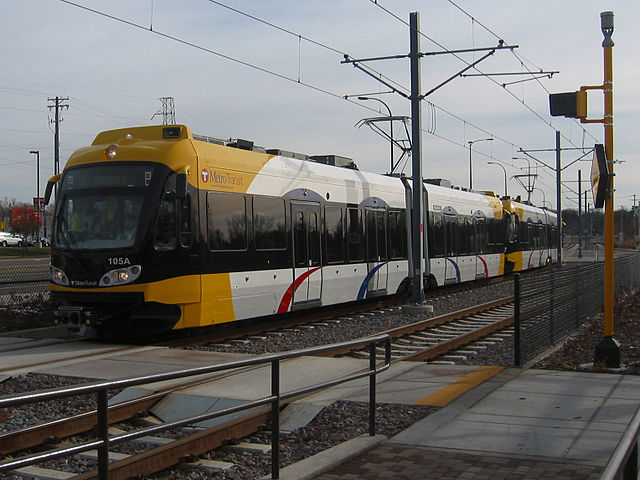
Matt Doll, Minnesota Environmental Partnership
Last week, municipal elected officials from several northwestern Twin Cities suburbs – Brooklyn Park, Crystal, Golden Valley, New Hope, and Robbinsdale – called on state and Metropolitan Council leaders to push harder for the construction of the Bottineau Blue Line project, which would extend Metro Transit’s light rail corridor to connect to these communities. The project has been in limbo for several years, largely due to stonewalling by the BNSF Railway company that does not wish to share its right-of-way with commuter rail. The elected officials ask the state and Met Council to push BNSF to negotiate, as they have done for other projects.
In their letter, the officials noted that these five cities are relatively diverse, and argued that the delays to the Bottineau project exemplify the systemic racism that has pervaded transit planning decisions in Minnesota (and the United States broadly) for years. The writers point out that “diverse communities along this line have a higher number of people living in poverty and experiencing transportation barriers than other areas that will be served by light rail.” Indeed, the Southwest Green Line extension, a similar light rail project that will stretch from Minneapolis to more affluent and more white communities in Hennepin County, has been approved and is currently under construction.
The Blue Line extension’s position in planning purgatory highlights a broader issue of environmental injustice: transportation investments tend to benefit affluent, white, and fossil-fueled interests at the expense of communities of color and a healthy environment. This is part of the reason that low-income and diverse communities suffer higher levels of air pollution than the rest of Minnesota, and why transportation is our largest, most stubborn source of greenhouse gas emissions.
This structural inequity has shown itself time and again throughout the Twin Cities’ history. The Twin Cities streetcar system, which for a time was considered one of the best in the United States, was dismantled by corporate raiders in the early 1950s, and light rail did not return until a half-century later. This coincided with policy changes that encouraged an ideal of individuals commuting in their own cars, as well as white flight and redlining that contributed to inequality.
One of the most egregious examples – and darkest chapters in Twin Cities history – was the literal destruction in the 1950s and 60s of the majority-Black Rondo Neighborhood in St. Paul to make way for I-94. Rondo community groups’ voices were largely ignored by state highway planners, and one in eight Black residents of the city lost their homes to the freeway. Four years ago, MNDOT and the City of St. Paul formally apologized for the resulting devastation, but the lingering harms – economic, social, and environmental – are still being felt.
Inequities and a bias towards fossil fuels are baked into the way that Minnesota plans and funds public transit even today. This year’s bonding bill – which the Legislature failed to pass after a regular session and two special sessions – contained funds to invest in currently-planned transit infrastructure, though it had no money for planning new routes and projects. But the bonding bill shouldn’t be the go-to solution for transit anyway. The Legislature has consistently refused or failed to pass a comprehensive transportation bill that supports transit riders or invests in the future, leaving gaps for bonding to fill. Metro Transit raised its fares in 2017 for the first time in 9 years, largely because the legislature did not fund it adequately to stave off a budget deficit. Ultimately, it was transit riders and the Twin Cities economy that suffered.
More widespread examples exist. The elimination of trees in low-income neighborhoods to create wider, faster roads. Zoning restrictions that prevent even modest increases in housing density. Speed limits that endanger pedestrians. Time and again, decisions that disadvantage people who can’t or prefer not to drive a single-occupant motor vehicle have been made in Minnesota, and coincide with detrimental effects on our climate, our air, and our ecosystems.
There are solutions available to these injustices and to our climate crisis. While electric vehicles are part of the overall solution, they won’t do the job by themselves – it’s critical to give people alternatives to driving. Investing more funds, more consistently in public transit is a core tool, and one that policymakers should not shy from during the COVID-19 crisis given what we’ve learned about the relative safety of public transportation under the right precautions.
State, city, and regional authorities need to build a foundation of trust with historically disadvantaged communities and listen receptively to their needs. Then they need to do the hard, necessary work of building equity in transportation.